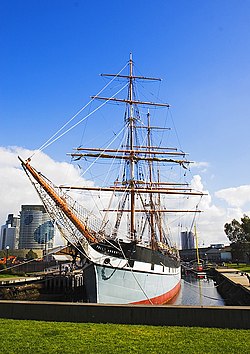 Polly Woodside is an iron-hulled, three-masted barque currently forming the major attraction of the Melbourne Maritime Museum.
| |
| History | |
|---|---|
| Owner |
|
| Builder | Workman, Clark & Co, Belfast |
| Launched | 7 November 1885 |
| In service | 7 December 1885 |
| Renamed | Rona, 1904[1] |
| Reclassified | Coal lighter 1922 |
| Homeport | Belfast, Northern Ireland (1885–1904), Lyttelton, New Zealand (1904–1912), Auckland, New Zealand (1912–1923), Sydney, Australia (1923–1925), Melbourne, Australia (1925–current) |
| Identification | KDCN |
| Status | Museum ship since 1968 |
| General characteristics | |
| Class and type | Cargo |
| Type | Iron hull, Barque rig |
| Tonnage | 678 gross |
| Length | Hull:192.2 ft (58.6 m)LOA:230 ft (70 m) |
| Beam | 30.15 ft (9.19 m) |
| Height | 108 ft (33 m) (mainmast) |
| Draught | 14 ft (4.3 m) |
| Propulsion | Sails |
| Speed | 14 kt |
| Capacity | 1,100 tons |
| Complement | less than 15 |
Polly Woodside is a Belfast-built, three-masted, iron-hulled barque, preserved in Melbourne, Victoria (Australia), and forming the central feature of the South Wharf precinct. The ship was originally built in Belfast by William J. Woodside and was launched in 1885. Polly Woodside is typical of thousands of smaller iron barques built in the last days of sail, intended for deep water trade around the world and designed to be operated as economically as possible.
- ^ "RONA SOLD". Daily Commercial News And Shipping List. No. 10, 667. New South Wales, Australia. 30 August 1922. p. 4. Retrieved 30 March 2017 – via National Library of Australia.